Geochemistry,geochronology,and zircon Hf isotopic compositions of felsite porphyry in Xiangshan uranium oref ield and its geological implication
Mingming Tian·Ziying Li·Jiangtao Nie·Jun Zhong·Jian Wang·Jianhui Cao
Abstract Recently,a new kind of volcanic rock,felsite porphyry,has been revealed by drilling in Xiangshan area,Jiangxi Province,China.To better understand petrogenesis and magmatic evolution sequence of the Xiangshan volcanic-intrusive complex,we studied systematic petrology,geochemistry,LA-ICP-MS zircon U-Pb dating,and Hf isotoperesultsof thefelsiteporphyry.Resultsshow that the felsite porphyry has similar geochemical characteristics to the porphyroclastic rhyolite,which is the predominant lithology of Xiangshan uranium oref ield.Felsite porphyry and porphyroclastic rhyolite have high SiO2,Al2O3,and K2O contents,low Na2O,and MgO contents,and slightly negative Eu anomalies.Moreover,these rocks are relatively depleted in large ion lithophile elements(K,Ba,and Sr)and areenriched in high f ield strength elements(Th,Zr,and Hf).LA-ICP-MS zircon U-Pb dating of the felsite porphyry yielded a crystallization age of 132.2±0.9 Ma,which is coeval to that of the porphyroclastic rhyolite.These ages signified that Xiangshan volcanic-intrusive complex formed in the Early Cretaceous,during which the entire South China was in the back-arc extension tectonic setting related to the subduction of the Pacif ic Plate under the Euroasian Plate.In-situ zircon Hf isotope data on a felsite porphyry sample showεHf(t)values from-8.82 to-5.11,while the Hf isotope two-stage model age(T DM2-Hf)ranges from 1513 to 1747 Ma.Combined with petrological, mineralogical, geochemistry, and geochronology results of the felsite porphyry,it is concluded that the felsite porphyry in Xiangshan might be originated from the partial melting of the Mesoproterozoic ancient metamorphic rocks,with possible input of small amounts of mantle materials.
Keywords Petrogeochemistry·LA-ICP-MSzircon U-Pb age·Hf isotope·Felsite porphyry·Xiangshan uranium oref ield
1 Introduction
Xiangshan uranium oref ield in Jiangxi Province is the largest volcanic type uranium oref ield in China,which attracted great attention and systematic studies focusing on petrology,mineralogy,ore geology,geochemistry,and geochronology(Fang et al.1982;Liu et al.1990;Wang et al.1991;Xia et al.1992;Chen et al.1999;Wu,1999;Wu et al.2003;Fan et al.2005,2009;Zhang and Li 2007;Zhang 2016;Yang et al.2009,2010;Li et al.2014;Wu et al.2017).Previous studies show that the volcanic activities in Xiangshan occurred from the Late Jurassic to the Early Cretaceous and lasted for~30 Ma from 160 to 130 Ma.In addition,most researchers believe that the volcanic-intrusive complex is mainly derived from the partial melting of felsic crust(Fan et al.2001a;Jiang et al.2005;Yang et al.2011;Guo et al.2016;Yu et al.2019).However,whether the rocks have the same source and whether mantle material was added or not remain to be controversial.Some scholars believe that all kinds of volcanic and sub-volcanic rocks in Xiangshan are products of partial melting of the same or similar magma source(Fang et al.1982;Fan et al.2001a;Jiang et al.2005;Yang et al.2011).Others believe that Xiangshan volcanic-intrusive complex was derived from a different magma source,with the input of mantle materials(Fan et al.2001b;Guo et al.2016).Different lithologies,including the acidic porphyroclastic rhyolite,rhyodacite,granitic porphyry,dacite porphyry,rhyolitic porphyry(Fan et al.2009;Yang et al.2009,2010;Zhou and Wang 2012;Wu et al.2017;Zhang 2016;Zhang et al.2018;He et al.2009;Yang et al.2009,2010;Yang 2013;Ruan 2018;Si et al.2018)and maf ic dykes like lamprophyre(Wang 2015;Wang et al.2019),were recognized and analyzed.Recently,a new type of concealed rocks,the felsite porphyry,was found from the boreholes in Heyuanbei and Lejia of mid-western Xiangshan area.Guo et al.(2014)conducted preliminary isotopic dating on the felsite porphyry intercepted by scientif ic deep drilling in the Xiangshan uranium oref ield.However,the petrogenesis remains poorly constrained,which hindered our understanding of the Xiangshan volcanic-intrusive complex.Therefore,in this manuscript,we present a systematic study of felsite porphyry on petrology,mineralogy,geochemistry,zircon U-Pb geochronology,and zircon Hf isotope geochemistry,to better understand the petrogenesis of the Xiangshan volcanic-intrusive complex.
2 Geological settings
Xiangshan uranium oref ield is located in the Jiangxi Province.Geotectonically,it lies within the Gan-Hang tectonic belt,which is close to the tectonic suture zone between the Yangtze plate and the Cathaysia plate(Fig.1).Xiangshan volcanic-intrusive complex,appearing as ellipses in-plane,occupies an area of about 309 km2,with length(east-west)of about 26.5 km,and width(north-south)of about 15 km.It isregarded asa large volcanic collapsed basin(Xia et al.1992;Zhang 2011),which can be divided into threelayers:the basement mainly composed of Early-Middle Proterozoic and Sinian metamorphic rocks,with local occurrences of the Lower Carboniferous and Upper Triassic series;The volcanic rocks are the major lithologies formed in Cretaceous in Xiangshan,and mainly composed of the rhyolitic crystal tuff,rhyolitic ignimbrite and rhyodacite of the Daguding Formation(K1d),and porphyroclastic rhyolite,granitic porphyry,rhyolitic dacite porphyry,quartz-monzonite porphyry and amprophyre of the Ehuling Formation(K1e).Of all the volcanic rocks,the porphyroclastic rhyolite is the predominant lithology and the host rocks of the uranium deposits in the Xiangshan basin.The Cretaceous red bed cover mainly includes sandstone and sandy conglomerate and the latest rocks recognized in the Xiangshan basin.
3 Samples and analytical methods
The felsite porphyry samples analyzed in this study were collected from the scientif ic deep drilling borehole CUSD3 in the Heyuanbei area and borehole CUSD4 in the Lejia area,in the midwestern Xiangshan area(Fig.1).The samplesare relatively fresh without alteration.The color of felsite porphyry is caesious.Felsite-porphyritic texture and massive structure(Fig.2a),some late carbonate veinlets and microf issures can be found(Fig.2b,f).The results of rock-mineral identif ication show that phenocrysts account for 25%-30%,which is dominated by quartz and sanidine,plagioclase followed.The quartz is mainly in the form of allotrimorphic granular,with aparticlesizeof 1-3 mm and a content of about 17%,in addition,embayment phenomenon can be seen occasionally(Fig.2c,d),but no obvious catalastic texture.Potash feldspar isin the shape of allotrimorphic-subeuhedral tabular,with a particle size of 1.5-3.5 mm and a content of about 13%,albitization,and chloritization alteration can be seen locally.While the plagioclase shows a higher degree of euhedral,mainly in the form of euhedral-subeuhedral tabular,2-4 mm,with a content of about 12%,sericitization occurs on some plagioclases(Fig.2e).Thematrix accountsfor 65%-70%,and mainly composed of feldspar-quartz minerals and a small amount of biotite,with uneven crystal granularity,the matrix also shows felsite texture,and the average particle size is less than 0.2 mm,some are less than 0.01 mm.

Fig.1 Geotectonic location a and geological sketch map b of Xiangshan uranium oref ield(Modified after Wang et al.2019)

Fig.2 Photographs showing the felsite porphyry core samples and major rock mineral composition.a Felsite porphyry core samples;b Carbonateveinlets;c Micrographsof felsiteporphyry(crosspolarized light);d Embayment of quartz in felsiteporphyry(crosspolarized light);e Sericitization of plagioclase(cross polarized light);f Micrographs of late carbonate veinlet(cross polarized light)
3.1 Major and trace elements analysis
The major and trace element compositions of the samples were analyzed in the Analytic Laboratory of Beijing Research Institute of Uranium Geology(ALBRIUG).Before testing,the samples were f irstly ground into 200 mesh.Major elements test was performed by the PW2404 X-ray f luorescence spectrometer.The specif ic operation is Using the XRF f luorescence spectrometer to analyze after the powder samples were made into a deplanate glass sheet,the analysis accuracy was better than 5%.Trace elements and REE were analyzed by plasma mass spectrometer(ICP-MS),and the sample processing method was as followed:Firstly,weighted 200 mg powder sample,mixed with a 900 mg LiBO2f lux uniformly,then melting in a furnace at 1000°C.Secondly,dissolving and diluting the melt with 100 mL 4%nitric acid after the melt was cooled,and then analyzing with ICP-MS,the analysis accuracy is 5%-10%.
3.2 LA-ICP-MS zircon U-Pb analysis
Zircons used for U-Pb dating were extracted from felsite porphyry powder samplesusing electromagnetic separation and heavy liquid suspension at the testing and analysis center of Beijing Research Institute of Uranium Geology.Then preferable crystal and representative zircons were selected under a microscope.The process of zircon targets,transmitted light,ref lected light and cathode luminescence(CL)images were completed by Beijing Zirconium Technology co.,Ltd.Based on the above process,zircon images were systematically studied,and the structure,texture,microf issures,and inclusions were identified clearly.Preferable crystal,clear crystal edge,and transparent magmatic zircons were selected for testing.LA-ICP-MS zircon U-Pb dating experiment was undertaken at State Key Laboratory of Continental Dynamics,Northwest University,Xi’an,China.The instrument model is Agilent7500 ICP-MS,which isequipped with ComPex102 ArF excimer laser(working substance is ArF and the wavelength is193 nm)and GeoLas200M optical system.During the experiment,Helium was used as the carrier gas of the denudation material.U concentration and U/Pb fractionation value of the unknown samples were corrected by alternating measured values of standard reference material for artif icial silicate glass NISTSRM610 from the National Institute of Standards and Technology(NIST)and the standard zircon 91500 from Harvard University.Raw data were processed using the GLITTER program,and the uncertainties of individual analyses are reported with 1σ error.Weighted mean ages were calculated at 1σconf idence level.The correction of normal lead by Anderson’s method(Anderson 2002),and the age calculation was completed by national standard program Isoplot ver3.0(Ludwing 2003).
3.3 Zircon Hf isotope analysis
Zircon Lu-Hf isotopein-situanalysis was also conducted at the State Key Laboratory of Continental Dynamics,Northwest University,Xi’an,China.The Nu Plasma HR multi-reception inductively coupled Plasma mass spectrometer(MC-ICP-MS)was used to complete zircon Lu-Hf isotopein-situanalysis which is near the U-Pb dating site. For Lu-Hf isotope measurement,176Lu/175Lu=0.02669 and176Yb/172Yb=0.5886 were used for isobaric interference to correct and calculate the ratio of176Lu/177Hf and176Hf/177Hf of the samples.During the testing process,the standard zircon samples 91500 and GJ1 were also tested and analyzed for instrumental quality control and sample calibration.In the calculation ofεHf(t),the recommended decay constant value of176Lu is 1.867×10-11year-1,the176Lu/177Hf and176Hf/177Hf values of the primitive mantle are 0.0332 and 0.282772respectively(Blichert et al.1997),and the depleted mantle model age of zircons Hf isotope was calculated using current (176Hf/177Hf)DM=0.028325 and(176Lu/177Hf)DM=0.0384.
4 Results
4.1 Major element analysis results
The major element results of felsite porphyry are listed in supplementary material Table 1.It isshown that therock is characterized by the enrichment of SiO2(72.53 wt%to 76.80 wt%),Al2O3(11.81 wt%to 13.37 wt%),and K2O,while depleted in Na2O and MgO.The total alkali(Na2-O+K2O)ranges from 5.59 wt%to 8.00 wt%,and the Na2O/K2O ratio is 0.43-0.86.Compared to the predominant porphyroclastic rhyolite and rhyodacite,the main lithology of Xiangshan area(listed in supplementary material Table 1),felsitic porphyry shows similar major element characteristicswith porphyrocalstic rhyolite,while few differences compared with rhyodacite,SiO2in felsite porphyry is higher,while Al2O3,Fe2O3,and FeO are relatively lower.Previous studies have been conducted on the characteristics of the major elements of intermediate-acid dykes in the Xiangshan area,including dacite porphyry,granitic porphyry(Ruan 2018;Wang et al.2019)(listed in supplementary material Table 1),compared with felsite porphyry,the results show that felsite porphyry presented by signif icantly higher SiO2,while lower Al2O3,Fe2O3,and FeO.In the TAS classif ication diagram of volcanic rocks(Fig.3),felsite porphyry,porphyroclastic rhyolite,and rhyolitic porphyry samples all fell in the rhyolite region.In the SiO2-AR classif ication diagram,all of the samples fell into the cal-alkaline region(Fig.4).
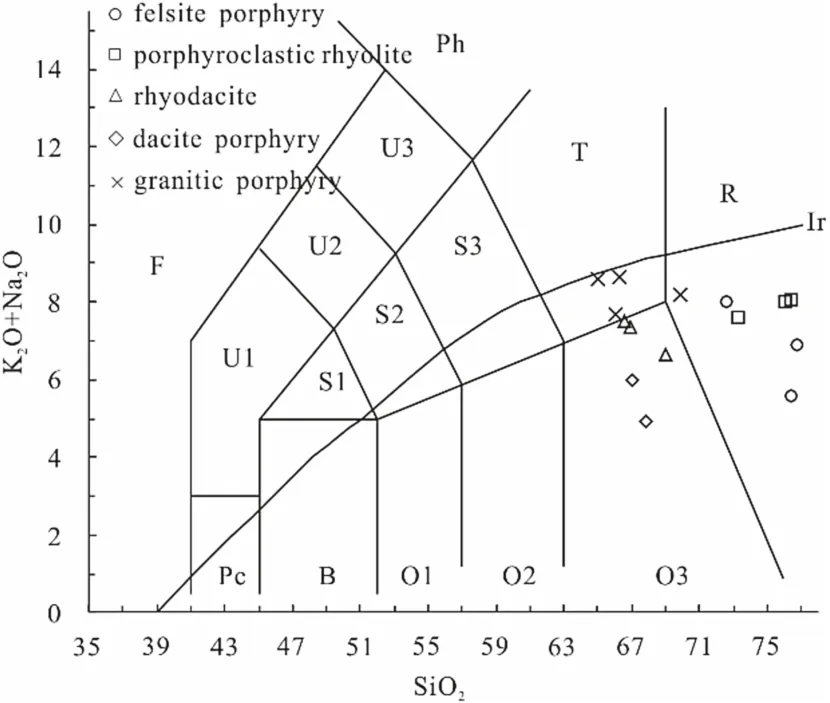
Fig.3 TAS classif ication diagram of felsite porphyry(after Le Maitre 1989).Pc-Oceanite;B-Basalt;O1-Basaltic andesite;O2-Andesite;O3-Dacite;R-Rhyolite;S1-Trachybasalt;S2-Basaltic trachyandesite;S3-Trachyandesite;T-Trachite,trachydacite;F-Feldspathoidite; U1-Tephrite, basanite; U2-Phonotephrite; U3-Tephriphonolite;Ph-Phonolite;Ir-Irvine boundary,upper is alkaline and below is subalkaline
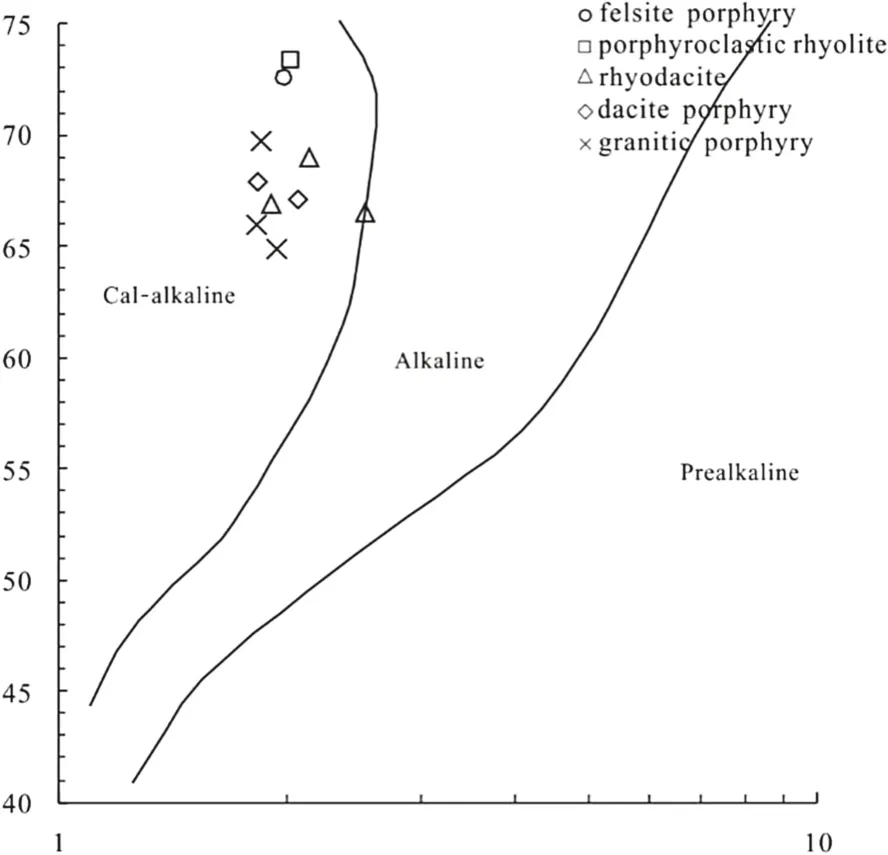
Fig.4 SiO2-AR classif ication diagram(Wright 1969).AR=[Al2O3-+CaO+(Na2O+K2O)]/[Al2O3+CaO-(Na2O+K2O)](wt%)
4.2 Trace element and REE analysis results
The trace element results are presented in supplementary material Table 2 and Table3.Compared to porphyroclastic rhyolite,rhyodacite,and intermediate-acid dykes(dacite porphyry,granitic porphyry,and rhyolitic porphyry)in the Xiangshan area(also listed in supplementary material Table 2 and Table 3),felsite porphyry also shows similar trace element composition. On primitive mantle normalized trace element spider diagram(Fig.5a),felsite porphyry shows almost the same pattern with porphyroclastic porphyry and rhyolitic porphyry,and only a slight difference with rhyodacite,dacite porphyry,and granitic porphyry could be observed.In addition,the felsite porphyry is characterized by the depletion of large ion lithophile elements(LILE,such as K,Ba,Sr)and high f ieldstrength elements(HFSE including Nb,Ti,P),and enrichment of Rb,Th,and Nd.The depletion of Sr and Ba indicated that the rock might undergo strong fractional crystallization of plagioclase,while the losses of P and Ti might be related to the fractional crystallization of apatite and rutile.
Thetotal rareearth element(∑REE)of felsiteporphyry concentrations range from 121.39 to 253.67 ppm,with enriched in LREE(LREE/HREE ratio ranges from 8.79 to 11.68)and signif icant negative Eu anomalies(Fig.5b,δEu ranges from 0.06 to 0.42).On chondrite normalized REE patterns(Fig.5b),the felsite porphyry shows a similar distribution pattern to the volcanic-subvolcanic felsic rocks in the Xiangshan area,especially with the porphyroclastic rhyolite.The similar trace element compositions suggest that thefelsite porphyry probably share a similar magmatic source and evolution history with the other felsic volcanic rocks in the Xiangshan area,both of which are products of the same magmatic activity at different stages.
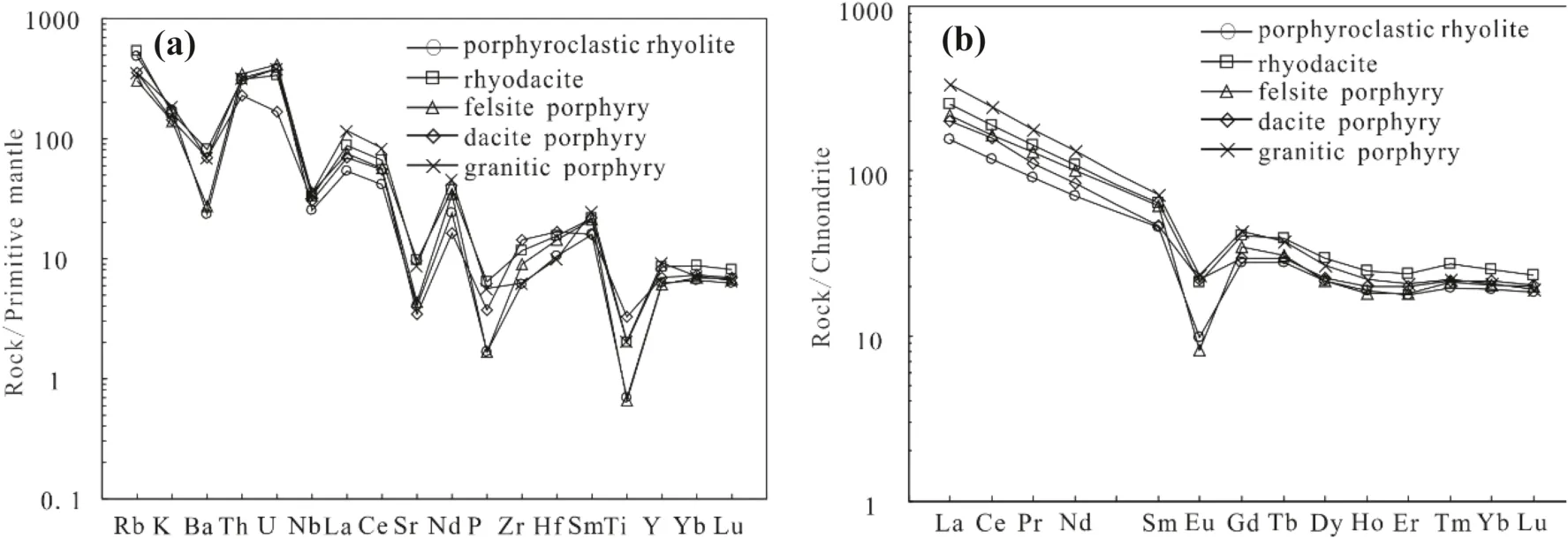
Fig.5 Primitive mantle normalized trace element spider diagram(a)and chondrite normalized REE patterns(b)of felsite porphyry(standardized data quote from Sun and McDonough 1989)
4.3 LA-ICP-MS Zircon U-Pb dating analysis
The zircon U-Pb dating sample(SD3-25)was collected from the CUSD3 borehole in Heyuanbei,Xiangshan.Cathode luminescence(CL)images of zircons(Fig.6)show that the zircons are mainly long-columnar and prismatic in shape,with colorless-transparent and yellowishyellow color.Oscillatory growth zoning could be recognized in most zircon grains,suggesting that the zircons for U-Pb dating are magmatic in origin.
In this study,14 analyses were performed on 12 zircons from felsite porphyry sample SD3-25 and the results are shown in Table1 and Fig.8.The U-Th-Pb analyses yield a range of U and Th concentrations of 43.03-1853.07 ppm and 21.73-664.98 ppm,with an average of 554.89 and 230.06 ppm,respectively.The Th/U ratios range from 0.31to 1.64(with an average of 0.58),which is similar to the typical magmatic zircons(Song et al.2002;Fernando et al.2003;Samuel and Mark 2003).The U-Pb analyses yield concordant or nearly concordant results within analytical error,with the207Pb/206Pb apparent ages ranging from 130.6 to 142.8 Ma(Table 1).Most zircons have typical oscillatory zones,yielding a concordant206Pb/238U age of 132.2±0.9 Ma(MSWD=0.38)(Fig.7).One relatively older age of 1062.1±12.5 Ma in the core of the zircon was recognized(spot 11,Table 1,Fig.6).
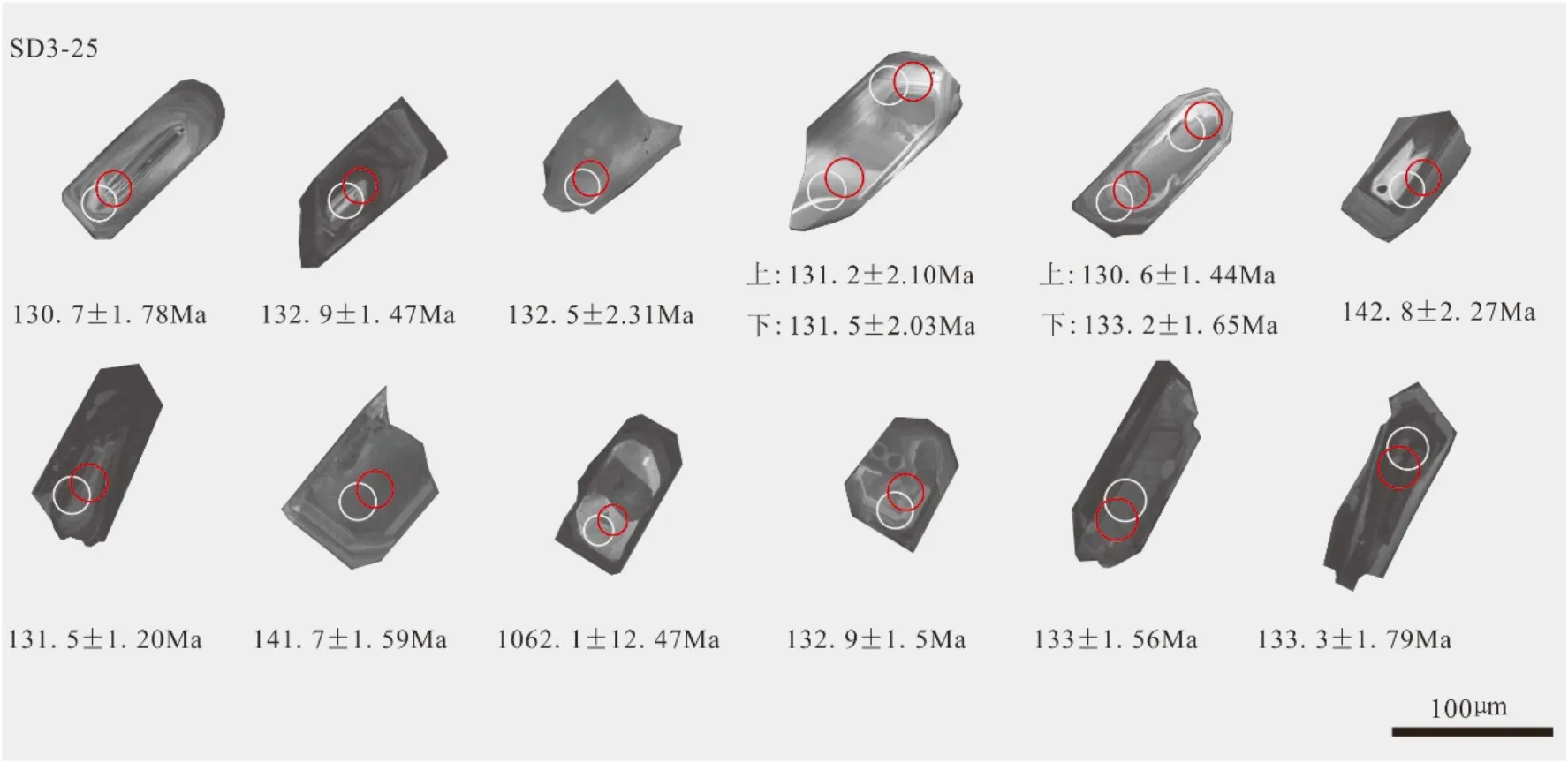
Fig.6 Zircon CL(cathodoluminescence)imagesof felsite porphyry.Note Thewhite circle and red circlerespectively represent the U-Pb dating location and Lu-Hf isotope dating location
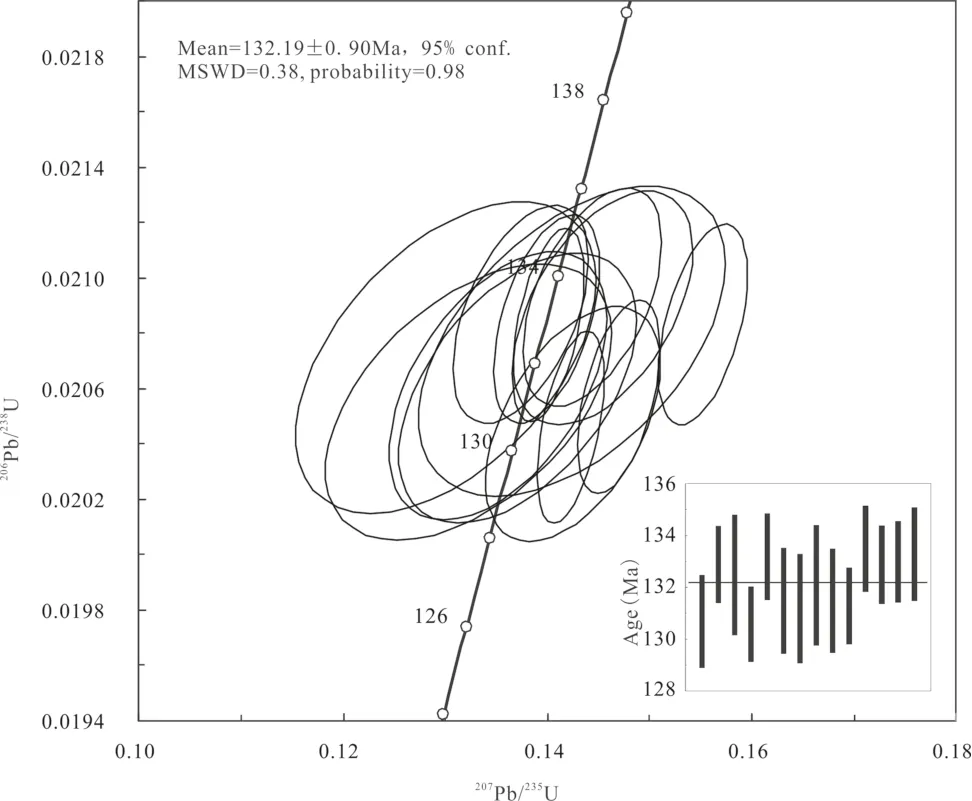
Fig.7 LA-ICP-MS zircon U-Pb age Concordia diagram and average-weighted age of felsite porphyry
To sum up,the age of felsite porphyry can be constrained to 132.2±0.9 Ma,suggesting that the felsite porphyry isaproduct of magmatic activity during the Early Cretaceous.
4.4 Zircon Lu-Hf isotopic compositions
Zircon Lu-Hf isotope analysis was performed on the same U-Pb dating zircons and the results are listed in Table 2.Generally,the zircons show very low radiogenic Hf accumulation,and the176Lu/177Hf.
ratio can represent the Hf isotope composition during crystallization of the zircons if the176Lu/177Hf ratio is less than 0.002(Hou et al.2007;Wu et al.2007).As shown in Table 2,the176Lu/177Hf ratio of felsite porphyry ranges from 0.000620 to 0.001789,176Hf/177Hf ratio ranges from 0.282444 to 0.282548,and the calculatedεHf(t)value ranges from-8.82 to-5.11(with only one exception of 14.46),and mostly concentrated between-8 and-6.5(Table 2 and Fig.8a).The single-stage model age of Hf isotope(TDM)ranges from 999 to 1148 Ma,and the twostage model age(TDM2)ranges from 1513 to 1747 Ma,mostly concentrated between 1500 to 1800 Ma(Fig.8b).

Fig.8 Histogram of εHf(t)(a)and two-stage Hf model age(b)of felsite porphyry

Table 1 LA-ICP-MS zircons U-Pb data of felsite porphyry
Meanwhile,the Hf isotope compositions of the porphyroclastic rhyolite of the Ehuling Formation from the Heyuanbei area were also analyzed and the results are listed in Table 2.The calculatedεHf(t)value varies from-9.46 to-4.45,and the two-stage model age(TDM2)varies from 1470 to 1787 Ma,which is extremely close to that of the felsite porphyroclastic rhyolite,indicating the possible same-origin between the felsite porphyry and porphyroclastic rhyolite.

Table 2 continued

Table 2 Lu-Hf isotopic data of felsite porphyry and porphyroclastic rhyolite
5 Discussion
5.1 The age of felsite porphyry
A series of studies on the formation age of volcanic-intrusive complex of Xiangshan uranium oref ield have been carried out in the early stage by K-Ar method and wholerock Rb-Sr method.The results vary in a large range from 160 to 130 Ma due to the low accuracy of the dating methods(Yu 2001;Wu et al.2003).Recently,with the development of high-precision isotope dating methods,the formation age of the volcanic-intrusive complex has been constrained to 136-130 Ma(Zhang and Li 2007;He et al.2009;Yang et al.2009,2011;Yang 2013;Chen et al.2013;Wu et al.2017).Yang et al.(2010)conducted SHRIMP and LA-ICP-MSzircon U-Pb dating on rhyodacite,and the result is 135.1±1.7 Ma.Meanwhile,the author carried out the LA-ICP-MSzircon U-Pb dating of porphyroclastic rhyolitein Heyuanbei,Xiangshan area,theagerangesfrom 131.6 Ma to 132.9 Ma(unpublished),these age data indicate that the volcanic-intrusive complex is a product of the same magmatic activity of different stages in the Early Cretaceous,and the rhyodacite is earlier than porphyroclastic rhyolite.
In recent years,a series of relevant studies were performed by some researchers in terms of the formation time of intermediate-acid dykes in Xiangshan uranium oref ield.The age of rhyolitic dacite porphyry has been dated to 136.6±2.7 Maby He et al.(2009)using the SHRIMPUPb method,which isrelatively consistent with LA-ICP-MS zircon U-Pb dating age of rhyolitic dacite porphyry(134.8±1.1 Ma)by Yang et al.(2010).Ruan(2018)conducted the LA-ICP-MSzircon U-Pb dating on granitic porphyry.The results range from 134 to 136 Ma,which is approximately close to rhyolitic dacite porphyry.Fan et al.(2005) reported the lamprophyre dyke age of 125.1±3.1 Ma by LA-ICP-MS zircon U-Pb dating.Wang et al.(2019)constrained the formation age of late dacite porphyry at Zoujiashan deposit to be 122.4 Ma by LA-ICP-MS zircon U-Pb dating.These ages indicate that multiple contemporaneous dyke magmatic activities occurred after the large-scale magma intrusive activity in the Xiangshan uranium oref ield in the Early Cretaceous.
In this study,the LA-ICP-MSzircon U-Pb age of felsite porphyry is 132.2 Ma,which is relatively consistent with that(132 Ma)of thefelsiteporphyry obtained by Guo et al.(2014)from scientif ic deep drilling of Xiangshan uranium oref ield.It isconf irmed that felsiteporphyry wasformed in the Early Cretaceous,and is much closer to the formation age of porphyroclastic rhyolite,which may be the products of the same-stage magmatic activity.
In conclusion,the large-scale Early Cretaceous volcanic-intrusive activity in the Xiangshan area may be formed in at least three stages within a relatively short period.The magmatic emplacement was initiated by the rhyodacite,rhyolitic daciteporphyry,and granitic porphyry at~136 Ma,which was followed by the formation of the porphyroclastic rhyolite and felsite porphyry at~131Ma.The small-scale magmatic activity of basic and intermediate-acid dykes(such as lamprophyre dyke,dacite porphyry,etc.)formed during 122~126 Ma.Marks the termination of the magmatic systems in Xiangshan area.
5.2 Tectonic setting
In recent years,the tectonic environment and geotectonic setting of magmatic activity in South China became one hotly debated topic and mainly two points of view can be summarized.Some researchers suggested that the magmatic rocks are products of arc-magmatism or syn-orogenic compression environment related to the subduction of the Pacif ic Plate(Yin et al.1999;Wang and Deng 2003,2004).The other group of geologists believed that the magmatic rocks were related to the extension-thinning of the intra-continental lithosphere(Li et al.1999;Wang et al.2000).Despite the controversy over‘‘associated with the subduction of the Pacif ic Plate to the west’’and‘‘plate within the lithosphere stretching and thinning effect’’on the magma-dynamics tectonic setting of South China in Yanshanian,a growing number of scholars believe that the extension of the lithospherein South China wasinitiated in the Early Yanshanian(Jurassic J2-J3)age(Chen et al.2002,2004;Wang et al.2000,2004;Zhou et al.2006;Jiang et al.2009;Zhong et al.2017a,b).The previous study shows that the magmatic activity in South China in the Cretaceous(Late Yanshanian:K1)was generated in an extensional environment(Yang et al.2010;Wang et al.2019),and characterized by active continental margin arc magma.Jiang et al.(2005)believed that the Xiangshan volcanic-intrusive complex represented alkali-rich,hightemperature A-typemagma,which wasformed in thebackarc extensional environment related to the subduction of the Paleo-Pacif ic Plate.
Porphyroclastic rhyolite age(131~132 Ma)(unpublished),rhyodacite age(135~136 Ma)(Yang et al.2010),and the felsite Porphyry age(132 Ma)conf irmed that the Xiangshan volcanic-intrusive complex wasformed in back-arc extensional stage related to the subduction of Paleo-Pacif ic Platetoward Asiacontinent in Cretaceous(Li et al.2017),when a series of Early Cretaceous fault basins were formed,accompanied by intense emplacement of intermediate-acid magmatic rocks(both intrusive and volcanic),Including the Xiangshan volcanic-intrusive complex.
5.3 Material source of felsite porphyry
Recent researches show that the Xiangshan volcanic-intrusive complex was mainly derived from the partial melting of the crust,with the input of the mantle materials at varying degrees(Fan et al.2001b;Jiang et al.2005;Guo et al.2016).As mentioned above,felsite porphyry shows similar geochemistry characteristics with Xiangshan volcanic rocks and sub-volcanic rocks,suggesting that the felsite porphyry has a nearly consistent magmatic source with Xiangshan volcanic rocks and sub-volcanic rocks.In addition,Yang et al.(2010)reported high initial87Sr/86Sr ratios(0.708837~0.715208)and lowerεNd(t)values(-7.44 to-8.16)of the rhyodacite,suggesting that the Xiangshan volcanic-intrusive complex is mainly derived from partial melting of the crust material.
Zircon is characterized by strong stability and higher systematical closuretemperatureof both the U-Pb and Lu-Hf isotopic systems,so the zircons can be used to trace the magmatic sources and illustrating the crust-mantle interaction processes(Griff in et al.2000,2002;Soderlund et al.2004).As mentioned above,the two-stage Hf isotope model ages of felsite porphyry range from 1513 to 1747 Ma(with an average of 1641 Ma),and theεHf(t)values range from-8.82 to-5.11(mostly concentrated between-8 and-6.5,with one exception of 14.46,Table 2 and Fig.8a).OnεHf(t)-206Pb/238U age diagram(Fig.9),the samples all fell below the chondrite line,indicating that felsite porphyry mainly derived from partial melting of the metamorphic rocks from the middle Proterozoic basement in the Xiangshan area.In addition,the similar Hf isotope compositions between felsite porphyry and porphyroclastic rhyolite of the Ehuling Formation in mid-western Xiangshan further indicates that the felsite porphyry shares a similar magmatic source with the volcanic-intrusive complex.
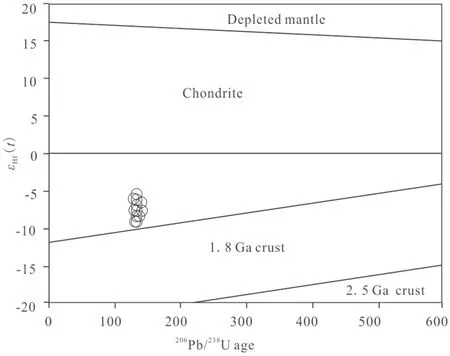
Fig.9 Zircon 206Pb/238U age andεHf(t)diagram of felsite porphyry
Besides the contribution of the crust,the input of the mantle materials has also been discussed in this contribution as follows.
According to Guo et al.(2015,2016),the two-stage Nd model age(tDM2)of porphyroclastic rhyolite and rhyodacite is about 1.66 Ga and 1.67 Ga,and the207Pb/206Pb,207Pb/235U,and206Pb/238U model ages of the oldest remaining zircons in the Xiangshan volcanic-intrusive complex are 1655.9 Ma,1727.7 Ma,and 1787.9 Ma,respectively,which is close to the formation age(1766±19 Ma)of the amphibolite basement rocks of the Cathaysia Block(Li et al.1998).This indicates that the material sources of the Xiangshan volcanic-intrusive complex dominated by Mesoproterozoic basement metamorphic rocks,also some new mantle-derived material components involved,which result in the general decrease of the Nd model age(Guo et al.2016).
Apatite is one of the main accessory minerals in granite,and the content of P2O5can distinguish rock type(Bea et al.1992).P2O5content of I-type and A-type granites decreases with the increase of SiO2content,while P2O5content of S-type granites increases or remain unchanged with the increase of SiO2(Li et al.2007).In Fig.10,there is a negative correlation between P2O5and SiO2in the Xiangshan volcanic-intrusive complex,indicating that the magma source is not a single partial remelting event of the metamorphic rocks,some mantle source materials might also involve.In addition,Fan et al.(2005)found maf ic microgranular inclusions in the granitic porphyry,which also contained a large number of acicular apatite.The research performed by Yang(2013)shows that the granitic porphyry containing maf ic microgranular inclusions and porphyroclastic rhyolite,rhyodacite without maf ic microgranular inclusions,have similar Nd-Hf isotopic compositions,which is further regarded to be the basic and acidic magma mixing process due to the large temperature differences between two kinds of magmas,although the magmatic mixing might only occur in shallow parts,with relatively less contribution of the mantle materials.
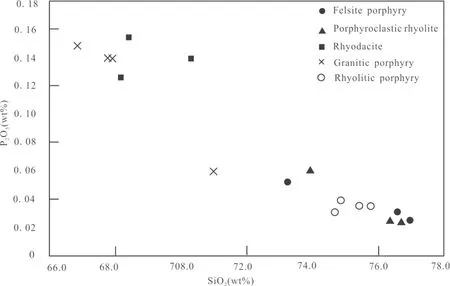
Fig.10 SiO2-P2O5 scatter diagram of Xiangshan volcanic-intrusive complex
All the above evidence indicates that the formation of the Xiangshan volcanic-intrusive complex is not only related to the partial melting of the crust,but also the input of small amounts of mantle materials.It is concluded that the felsite porphyry is mainly related to the partial melting of Mesoproterozoic basement metamorphic rocks,with the input of small amounts of the mantle materials.
6 Conclusions
1. LA-ICP-MS zircon U-Pb dating of felsite porphyry yielded a mean206Pb/238U age of 132.2±0.9 Ma,which is close to that of the porphyroclastic rhyolite.
2. Felsite porphyry shares similar geochemistry characteristicsand zircon Hf isotopic compositionswith other volcanic rocks of the Xiangshan volcanic-intrusive complex(especially porphyroclastic rhyolite),suggesting that they are the products of the same magmatic activity in different stages.
3. Xiangshan volcanic-intrusive complex,including the felsite porphyry,was formed at the back-arc extension settings related to the subduction of the Pacif ic late toward the Asia continent,and they are mainly formed by partial melting of the Mesoproterozoic basement metamorphic rocks,with the input of the small amount of mantle materials.AcknowledgementsThis study is supported by‘‘Comprehensive Study of 3D Metallogenic Geologic Environment of Key Zones for Exploration in Xiangshan Uranium Oref ield’’,the sub-project of‘Longcan Science and Technology Innovation Demonstration Project’’of China National Nuclear Corporation(Project No.:LCD116).
Acta Geochimica2021年5期
- Acta Geochimica的其它文章
- Source characteristics and genesis of Sb mineralization from the Au and Sb deposits of the Youjiang Basin,SW China:constraints from stibnite trace element and isotope geochemistry
- Late Jurassic adakitic ore-bearing granodiorite porphyry intrusions in the Xiaokele porphyry Cu(-Mo)deposit,Northeast China:implications for petrogenesis and tectonic setting
- Mineralogy and geochemistry of the Ngaoundaba Crater Lake sediments,northern Cameroon:implications for provenance and trace metals status
- Re-Osdating,and Pb-H-O isotopecharacteristics,of the Abra Cu-Ag-Pb-Au polymetallic deposit in Western Australia
- Geochemistry of platinum-group elements in the podiform chromitites and associated peridotites of the Nain ophiolites,Central Iran:Implications for geotectonic setting
- Geochemistry and provenance of the lower-middle pliocene cheleken formation,Iran
